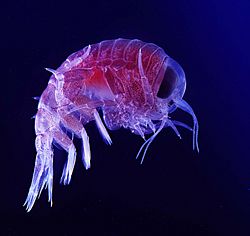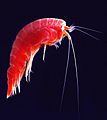Difference between revisions of "Amphipod" - New World Encyclopedia
Rick Swarts (talk | contribs) (added article from Wikipedia and credit/category tags) |
Rick Swarts (talk | contribs) |
||
| Line 20: | Line 20: | ||
[[Ingolfiellidea]] | [[Ingolfiellidea]] | ||
}} | }} | ||
| − | ''' | + | '''Amphipod''' is any of the small, largely marine, [[shrimp]]-like [[crustacean]]s comprising the [[arthropod]] order '''Amphipoda'''. Included among the amphipods are the abundant sand-hoppers or beach-fleas, the predaceous ghost shrimp, the [[whale]] ectoparasites ''Cyamus''. |
| − | + | ==Description== | |
| + | Amphipods are poor swimmers, being highly modified as bottom crawlers and scavenging macrophages (Russell-Hunter 1969). They lack a caprapace, have sessil eyes, the pleopods are respiratory in function, and the uropods do not form a tail fin (Russell-Hunter 1969). Amphipods typically are laterally flattened and normally have a division of functions among the varied limbs (Russell-Hunter 1969). | ||
==Distribution and life== | ==Distribution and life== | ||
| − | Many species of pelagic amphipods are [[Mutualism|mutualistic]] or (usually) [[Parasitism|parasitic]], living in association with [[jellyfish]] and [[salp]]s. ''[[Phronima]]'' is a relatively common genus of pelagic amphipod that kills and cleans out the barrel-shaped body of a | + | Most amphipods are [[marine (ocean)|marine]]; although a small number of species are [[fresh water|limnic]] or [[terrestrial animal|terrestrial]]. Marine amphipods may be [[pelagic]] (living in the water column) or [[benthic]] (living on the ocean bottom). Pelagic amphipods are eaten by [[seabird]]s, fish, and marine mammals. Terrestrial amphipods such as [[sand flea]]s can often be seen among sand and pebbles or on beaches. |
| + | |||
| + | Many species of pelagic amphipods are [[Mutualism|mutualistic]] or (usually) [[Parasitism|parasitic]], living in association with [[jellyfish]] and [[salp]]s (a barrel-shaped, free-floating [[tunicate]]). ''[[Phronima]]'' is a relatively common genus of pelagic amphipod that kills and cleans out the barrel-shaped body of a salp to live inside and raise its young. | ||
[[Image:Amphipod anatomy en.svg|thumb|left|275px|Amphopod anatomy]] | [[Image:Amphipod anatomy en.svg|thumb|left|275px|Amphopod anatomy]] | ||
Of the relatively few species of free-living, [[plankton]]ic amphipods, the most abundant of all is ''[[Themisto gaudichaudii]]''. Living in the [[Southern Ocean]], this amphipod congregates in dense swarms, where it is a voracious predator of [[copepod]]s and other small members of the [[zooplankton]]. | Of the relatively few species of free-living, [[plankton]]ic amphipods, the most abundant of all is ''[[Themisto gaudichaudii]]''. Living in the [[Southern Ocean]], this amphipod congregates in dense swarms, where it is a voracious predator of [[copepod]]s and other small members of the [[zooplankton]]. | ||
Revision as of 18:16, 7 August 2007
| Amphipoda | ||||||||||
|---|---|---|---|---|---|---|---|---|---|---|
 A hyperiid amphipod (Hyperia macrocephala)
| ||||||||||
| Scientific classification | ||||||||||
| ||||||||||
|
Gammaridea |
Amphipod is any of the small, largely marine, shrimp-like crustaceans comprising the arthropod order Amphipoda. Included among the amphipods are the abundant sand-hoppers or beach-fleas, the predaceous ghost shrimp, the whale ectoparasites Cyamus.
Description
Amphipods are poor swimmers, being highly modified as bottom crawlers and scavenging macrophages (Russell-Hunter 1969). They lack a caprapace, have sessil eyes, the pleopods are respiratory in function, and the uropods do not form a tail fin (Russell-Hunter 1969). Amphipods typically are laterally flattened and normally have a division of functions among the varied limbs (Russell-Hunter 1969).
Distribution and life
Most amphipods are marine; although a small number of species are limnic or terrestrial. Marine amphipods may be pelagic (living in the water column) or benthic (living on the ocean bottom). Pelagic amphipods are eaten by seabirds, fish, and marine mammals. Terrestrial amphipods such as sand fleas can often be seen among sand and pebbles or on beaches.
Many species of pelagic amphipods are mutualistic or (usually) parasitic, living in association with jellyfish and salps (a barrel-shaped, free-floating tunicate). Phronima is a relatively common genus of pelagic amphipod that kills and cleans out the barrel-shaped body of a salp to live inside and raise its young.
Of the relatively few species of free-living, planktonic amphipods, the most abundant of all is Themisto gaudichaudii. Living in the Southern Ocean, this amphipod congregates in dense swarms, where it is a voracious predator of copepods and other small members of the zooplankton.
After copepods, krill and salps, which are mostly herbivorous, the carnivorous Themisto is the most abundant member of the mesozooplankton in the Southern Ocean.
In cold seas, benthic amphipods are enormously diverse and abundant. In the Southern Ocean, amphipods are the most abundant benthic crustaceans. Some are grazers, many are omnivorous, some even act as piranha-like scavengers, quickly cleaning the carcasses of dead animals. Amphipods are one of the few animal groups frequently seen when submarines venture to the deepest parts of the oceans. Other benthic amphipods are the primary food of Gray Whales.
A ship hull fouling species of amphipod common to Atlantic and estuarine waters is Jassa falcata.
External links
- Amphipoda page at www.crustacea.net includes a list of families
- The Amphipod Home Page
- A database of amphipod literature
Credits
New World Encyclopedia writers and editors rewrote and completed the Wikipedia article in accordance with New World Encyclopedia standards. This article abides by terms of the Creative Commons CC-by-sa 3.0 License (CC-by-sa), which may be used and disseminated with proper attribution. Credit is due under the terms of this license that can reference both the New World Encyclopedia contributors and the selfless volunteer contributors of the Wikimedia Foundation. To cite this article click here for a list of acceptable citing formats.The history of earlier contributions by wikipedians is accessible to researchers here:
The history of this article since it was imported to New World Encyclopedia:
Note: Some restrictions may apply to use of individual images which are separately licensed.


